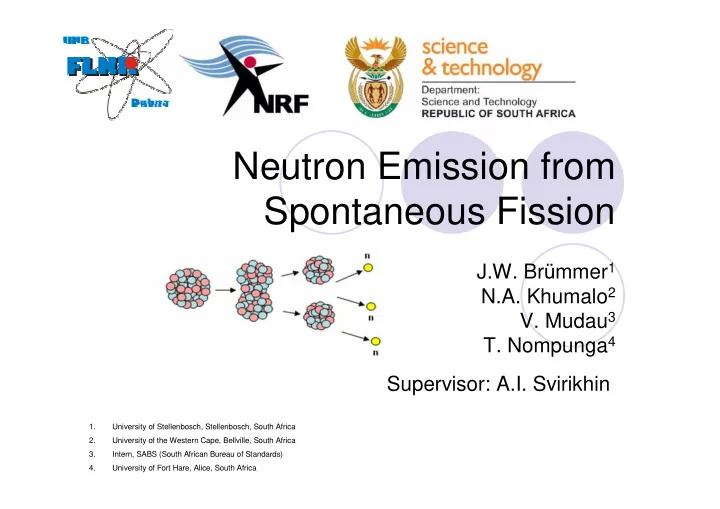

Neutron Emission from Spontaneous Fission J.W. Br ü mmer 1 N.A. Khumalo 2 V. Mudau 3 T. Nompunga 4 Supervisor: A.I. Svirikhin 1. University of Stellenbosch, Stellenbosch, South Africa 2. University of the Western Cape, Bellville, South Africa 3. Intern, SABS (South African Bureau of Standards) 4. University of Fort Hare, Alice, South Africa
Experimental Goals l Calibration of the Silicon detector; l Quantify the different amount of isotopes in the target; l Determine neutron lifetime within the detector; Determine the efficiency of the detector. l 2
Introduction: The Basics l What is Spontaneous Fission l SF is a form of nuclear radiation where a nucleus splits into two fragments and emits neutrons and gamma rays; l In elements heavier than xenon (Z=54), there is a decrease in binding energy per nucleon as atomic number increases; In this region of nuclear size, electromagnetic repulsive forces are l beginning to overcome the strong nuclear force attraction. 3
Relevant Theory l For the reaction to be possible, a very important principle has to be obeyed: Conservation of energy: E i = E frag + E n 0 +Q l l The initial energy before spontaneous fission has to be conserved; The energy after spontaneous fission will be distributed l between the fission fragments and the emitted neutrons; Q>0 for reaction to take place. l l Typical Reaction: l Neutron capture: 4
Relevant Theory 5
Experimental Setup l VASSILISSA separates ER’s from beam and reaction by-products with 3 electrostatic deflectors; l Each has a specific pre-set potential difference that only allows the wanted isotope to travel through the detector; 6
Experimental Setup l The isotope then travels to a position sensitive detector array where it decays; The decay products, fission fragments and alpha particles, are detected by the silicon l detector. l The transportation time of ER to the focal plane detector is a few microseconds which allows for investigation of very short-lived isotopes. 7
Experimental Setup 16 Layer Si detector Boron polyethylene shielding 6 Pre-amps from Si detector Vacuum Chamber He-3 Chambers 8
Experimental Setup Boron polyethylene shield Si detector in vacuum chamber He-3 filled tubes 9
Resolution and Calibration l The FWHM of each peak can be measured to obtain the average resolution of the detector: resolution ≈ 30 keV (0.6%). l Calibration was done by comparing the alpha spectra of the three isotopes used in the experiment: 244 Cm, 246 Cm and 248 Cm. 10
Calibration of Si-detector 248 Cm ⟹ 98,947% 246 Cm ⟹ 1,052% 244 Cm ⟹ 0.002% 11
Neutron lifetime in Detector l The detector has a 128 µs window to allow for neutron lifetime measurement. The t max value will then be 128 µs. The graph shows the exponential nature of the lifetime and the exponential l fit which yielded the average neutron lifetime. 12
Detector efficiency ε = 39.6% 13
The 252 No Isotope: Neutron Multiplicity 206 Pb + 48 Ca = 2n + 252 No Target: 350 μ g/cm 2 206 Pb Beam: 48 Ca - E 1/2 = 223 MeV Intensity: 0.5 p μ A (3x10 12 pps) σ = 200 nbarn ν = 4.06±0.1 neutr. per SF Earlier reported values 4.15±0.3 (Lazarev - 1977) 4.43±0.45 (Yeremin – 2004) 14
Experimental Results 15
Experimental Results 16
Conclusion l From our study of the neutron detector we have found the following attributes: l The neutron detector has zero crosstalk; l It has a high energy threshold with low gamma sensitivity & low internal background; l The detector has a relatively high efficiency; The neutron multiplicity could be measured owing to the l absence of crosstalk and the detector’s high energy threshold. 17
Acknowledgements l Our research group would like to thank the JINR and for the opportunity of working at the FLNR; l Thanks to our supervisor Alexander Svirikhin and to our co-supervisor Malyshev Oleg (FLNR); Thanks to the South African organizers Prof. Lekala, l Dr. Jacobs and Mr. Vusi Malaza; l Furthermore we acknowledge the contribution of the NRF and DST South Africa that made this research opportunity possible. 18
References l [1] A. I. Svirikhin, A. V. Isaev, A. V. Yeremin, et al., Nucl. Instr. and Meth ., 54 (2011) p. 644–648 [2] A.I. Svirikhin, V.N. Dushin, M.L. Chelnokov, et al., Eur. Phys. J ., A44 l (2010) p. 393–396 l [3] A.V. Andreev, D.E. Katrasev, A.N. Kuznetsov, et al., Eur. Phys. J ., A48 (2012) p. 121-126 l [4] E.A. Sokol, V.I. Smirnov, S.M. Lukyanov, et al., Nucl. Instr. and Meth ., A400 (1997) p. 96-100 l [5] D.C. Hoffman, et al., J. Nucl. Phys. , A502 (1989) p. 21-39 l [6] M. Gupta, A. V. Eremina, I. N. Izosimova, et al., Phys. of Part. and Nuclei , 9 (2012) p. 24–28. l [7] N.E. Holden, M.S. Zucker, Nucl. Data for Basic & Applied Science, Proc. Of the Int. Conf., Santa F é , New Mexico, 1985 vol. 2 (p. 1631) 19
20
Recommend
More recommend